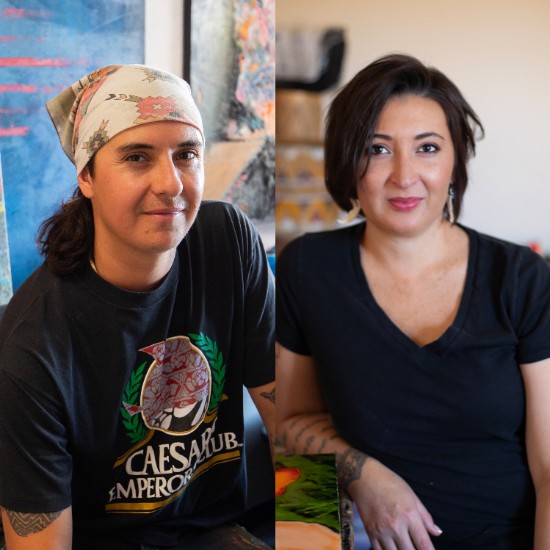
Helen K. Tindel
Paintings, works on paper
Helen K. Tindel’s relationship with art is innate. It’s often said that it’s in her blood. However, like all relationships, that between Helen and art has evolved throughout her life. Immersed in art since birth, Helen was born in 1987 to creative parents in Albuquerque, New Mexico. On her paternal side was her father, Greg Tindel, an artist and framer, and on her maternal side were three…
Helen K. Tindel’s relationship with art is innate. It’s often said that it’s in her blood. However, like all relationships, that between Helen and art has evolved throughout her life. Immersed in art since birth, Helen was born in 1987 to creative parents in Albuquerque, New Mexico. On her paternal side was her father, Greg Tindel, an artist and framer, and on her maternal side were three generations of Santa Clara painters, great-grandmother Pablita Velarde, grandmother Helen Hardin, and mother Margarete Bagshaw. Though born into a family of artists, Helen did not make art for the first two decades of her life. In youth, she felt pressure and confinement in being the fourth in a legendary matrilineal painting dynasty. She aspired to be anything but an artist; she spent her school years playing hockey, snowboarding, and studying, hoping to pursue a profession such as lawyering or accounting. At her mother’s gallery, she looked on at her family as an outsider. Instead of taking independent interest in her, it seemed others would only ask about her following in her dynasty’s footsteps.
Years later, during a summer break from her economics and Spanish studies at the University of New Mexico, 22-year-old Helen would often visit her mother at her gallery. It was late July in the hectic weeks preceding Indian Market, and her frantically prepping mother had no time to talk, so she insisted Helen busy herself. She gave Helen a pen and panel, suggesting she draw. It began as a way to kill time, but as the drawing developed, Helen felt a calmness she had never experienced while busy. With encouragement from her parents, Helen developed the piece, adding color. Then, her father framed it. By the time the Indian Market show was ready to open, Helen had completed her first work, a painting of her mother’s studio. Her mother hung it in the show, and much to Helen’s delighted surprise, it sold.
Helen would later learn that her mother had bought the painting. But it didn’t matter – the delight remained, and as she kept painting, the positive feedback persisted. It felt good to create in her own style and to be authentically accepted for it. The discomfort around art that consumed her in youth faded, and she finally felt safe to create in a way that was uniquely hers. She explored art from Klimt to Basquiat, experimenting with materials and methods in her father’s studio. Creating art brought her closer to her family and to herself.
Her relationship with art changed again when her mother passed in 2015. Her mother and her art had always been closely tied, and without her, everything shifted. Helen took a break from painting, beginning again in secret years later with a completely new focus. She connected with her mother through painting; it served as a cathartic way to mourn, process, and reflect. Intentionality and rawness appeared in the new work. Abstract and evocative compositions mirrored the intense emotions she felt. Her art was visceral. Then, evolving again, the flowers appeared, both as an honor to her mother and to her ancestral New Mexico homeland. Flowers became a repeated motif in her work. She recalls her mother telling her as a child, “I love you in the same way the sun shines on the flowers”.
These secret paintings were revealed in her first show at Blue Rain Gallery, where they were hung alongside the work of her mother, grandmother, and great-grandmother. That show opened in 2019, and Helen hasn’t stopped since. While ‘artist’ has become integral to her identity, her other passions remain important, and when she’s not painting, she can be found working her intellectual day job or exploring the outdoors. Today, Helen harmonizes her relationships with art, family, nature, and her homeland in her paintings. For her, painting is a practice in mindfulness. She equates it to journaling; putting herself on a canvas, allowing emotions to boil through in a therapeutic process. Her art exists as a product of perceptions, as her unique interpretation of her experiences. And in the same way that Helen’s emotions influence her art, she hopes that her art influences the emotions of others – an evocation of feeling in the viewer is her mark of accomplishment.











